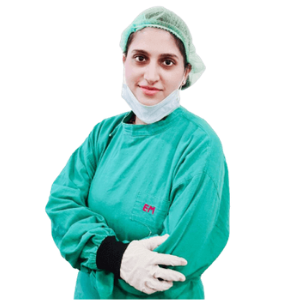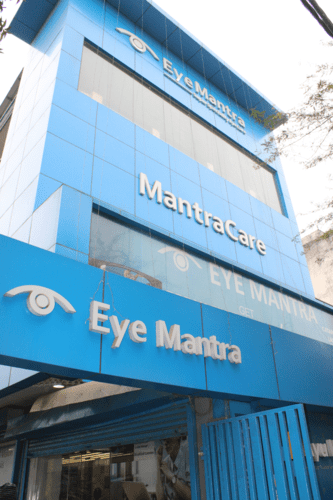Glaucoma Surgery
Glaucoma ( also known as Kala Motia) is essentially a group of related eye disorders which cause damage to the optic nerve of the eye. The optic nerve of the eye is responsible for transmitting images to the brain. Glaucoma, if not contained and treated can lead to severe damage as well as Total Permanent Blindness. Many a time, glaucoma causes no pain or discomfort until the vision loss starts. Hence, it is essential to do regular checkups in order to detect and contain eye diseases like glaucoma. Consult with Eyemantra, one of the best eye doctors across Delhi/ NCR providing with the best consultation and eye-care facilities.
Book Appointment

Glaucoma: What Is It?
Glaucoma is generally associated with a buildup of pressure inside the eye (Intraocular Pressure {IOP}) because the fluid inside the eye aqueous humor, stops draining from the eye normally. The fluid in the eye drains out from the trabecular meshwork and in Glaucoma, this drainage gets blocked leading to pressure buildup. The fluid pressure buildup can be attributed to intrinsic deterioration of the optic nerve as well as genetic factors.
Types Of Glaucoma
Open-angle Glaucoma (OAG)
Primary Open-Angle Glaucoma(POAG), Normal Tension Glaucoma (NTG), Pigmentary Glaucoma, Pseudoexfoliation Glaucoma, Secondary Glaucoma
Angle-closure Glaucoma
The type of Glaucoma in which the fluid cannot access the drainage angle of the eye. The drain space between iris and cornea becomes too small.
Primary Open-angle Glaucoma (POAG)
POAG is a very common type of glaucoma. In this type of eye defect, the peripheral vision of a person is diminished without presenting any other symptoms.
Acute Angle-closure Glaucoma
Acute Angle-Closure Glaucoma produces sudden symptoms such as eye pain, headaches, halos around bright lights, dilated pupils, red eyes, nausea etc.
Normal-Tension Glaucoma
Primary Open-Angle Glaucoma(POAG), Normal Tension Glaucoma (NTG), Pigmentary Glaucoma, Pseudoexfoliation Glaucoma, Secondary Glaucoma
Pigmentary Glaucoma
This a rare form of Glaucoma and it is caused by the clogging of the drainage angle of the eye. Affects males in the age group of 30-40 years of age.
Secondary Glaucoma
This is a type of glaucoma which could arise from factors other than natural factors and could be attributed to things like an eye injury or an infection, inflammation.
Congenital Glaucoma
This is basically a type of glaucoma that has been inherited by a child at birth from their parents. These kids are born with a defect in the drainage system.
Who Is At Risk Of Glaucoma?
- People over the Age of 40
- Have a family history of Glaucoma Problems
- People of Asian, Hispanic, African Heritage are more susceptible to having glaucoma.
- Individuals having high eye-pressure
- People who have far-sightedness(Myopia) and/or near-sightedness (Hyperopia)
- People with serious Eye Injuries
- People who have had long-term use of steroids or other medications
- People with thin corneas in the centre
- Thinning of the Optic Nerve
- People who immuno-deficiencies like diabetes, migraines, high blood pressure and have poor blood circulation
How To Reduce Glaucoma Risk
Glaucoma is not a condition that presents any noticeable symptoms till ill effects begin. This disease can also not be fully treated it just needs to be managed, therefore, it is vital to understand how to reduce the risk of complete loss of vision. Here are some steps to reduce the risks of glaucoma. Since there are no apparent symptoms at first it is advisable to get a comprehensive eye examination once every few weeks or at least 1 month.
- Do not stop taking corrective eye-drops prescribed by the ophthalmologist even though they might be causing slight discomfort.
- Informed management of the condition along with ongoing follow-up exams is pivotal to eliminate vision loss.
- Many researchers have found that regular exercise, maintaining a fit and active lifestyle along with dropping bad habits like smoking and alcohol abuse could go a long way in preventing as well as managing glaucoma
Glaucoma Symptoms
Glaucoma has been deemed by many doctors as the ‘silent thief of vision ‘ as it presents next to none or very little symptoms and many symptoms present themselves only after significant damage has been done to your vision. However, based on what type of glaucoma you might have there are certain symptoms there might be for early detection and management of glaucoma.
Open-Angle Glaucoma
Sadly, this type of glaucoma presents no symptoms before there has been a significant loss of vision. It is advised that if you feel at risk of glaucoma due to family history, you should keep getting comprehensive eye examinations on a regular basis. This will help track, diagnose and help manage this defect better.
Chronic Open-Angle Glaucoma (COAG)
This first sign of this type glaucoma is a loss of side vision/ peripheral vision. However, the changes are subtle and hence can be tough to acknowledge.
Acute Closed-Angle Glaucoma
Many people have described this as “the most traumatic eye pain of my life”. This glaucoma type produces some of the most painful symptoms.
- Throbbing eye pain
- Eye Redness
- Headaches
- Blurry or Foggy Vision
- Dilated Pupils
- Nausea and Vomiting
Congenital Glaucoma
Congenital glaucoma occurs in kids since their birth and the symptoms for the same could pop up in the first few years. These include
- Tearing, Sensitivity to light, along with eyelid spasms
- Enlarged cornea and clouding of the transparent cornea
- Habitual Rubbing of the eyes, squinting or keeping eyelids close the majority of the time.
Surgical Options For Glaucoma
Surgery has not been advised as the first solution to treat glaucoma however, it might be left as your last option if other treatments and management fail to produce the desired results.
Initially, your eye doctor will give you a prescription eyedrop or some form of oral medicine in order to ease the pressure on your eyes. However, if these drugs do not produce any results, surgery will be required to avoid loss of vision.
Various Types of Surgical Procedures for treating Glaucoma are as follows:
- Laser Surgery : This is basically used to clear up the clogged tubes and relive the built-up fluid pressure. Laser surgical procedures for glaucoma are also of several types as listed below:
- Argon Laser Trabeculoplasty (ALT)
- Selective Laser Trabeculoplasty (SLT)
- Laser Peripheral Iridotomy (LPI)
- Cyclophotocoagulation
- Trabeculectomy : In this procedure, the surgeon will make a small cut in the sclera (white part of the eye) and remove some mesh of tissue. This is supposed to help with the drainage of fluid in the eye and relive some IOP pressure.
- Drainage Implant Surgery : Since in glaucoma, the drainage system of the eye starts faltering, one of the ways to drain the fluid from the eyes is to implant an artificial system with a tube to drain out the fluid.
- Electrocautery : In this procedure, the surgeon uses a heating device called a Trabectome to make an incision in the eye’s drainage tube. This sends heat to the mesh of the tissue and helps relieve the fluid build up as well as the pressure.
Post Operation Care
During the surgery, you will be feeling very drowsy as you will be given some medicines to numb your eye and also relax you.
Post the operation, it is advisable to rest for at least a minimum time period of 7 days. Doctors advise not to participate in any of the following activities:
- Driving
- Reading
- Bending Over
- Lifting anything heavy for 4 weeks
Risks With Glaucoma Surgery
No surgical procedure is free from complications and we at EyeMantra as doctors have the responsibility to inform you of all the risks, after effects and complications involved in surgery. Here are some of the risks and complications that can occur with surgical treatment for glaucoma.
- Eye Pain or Redness
- Too high or too low Eye pressure
- Infection
- Cataracts development later in life
- Inflammation
- Bleeding in the eye.
Though there will always be complications and risks involved with risky procedures for the eye, surgical treatment of these eye problems could lead to significant improvement in the quality of life.
Our Team

Dr Shweta Jain
Cataract, Retina, LASIK

Dr Neha Wadhwa
Cataract, Retina, LASIK

Dr. Lalit Chaudhary
Femtosecond LASIK

Dr. Poonam Gupta
Femtosecond LASIK
Eyemantra- Famous For Glaucoma Surgery In Delhi
Eyemantra is the lead in Glaucoma treatment with over more than 1000 eyes operated. Book an appointment with our best Glaucoma eye doctorto know more about cataract surgery cost in Delhi.
Eye Mantra Foundation believes in giving back to society and so to complete this mission, we have set up Charitable Eye Hospitals, which cater to the needs of people who have one or another form of eye ailment but do not have the means to afford the treatment.
- Our mission is to provide affordable eye care to everyone.
- Being an enthusiastic leader in the eye care sector, we have state of the art technologies for eye treatments.
- We have started this charitable hospital to make sure that even the poorest strata of society, has access to the best eye care treatment methods.
- We believe in giving back to the society and so for this particular purpose, EyeMantra provides it’s services to the poor sections of society at no cost.

Frequently Asked Questions
Does increased eye pressure mean that I have glaucoma?
Not necessarily. Increased eye pressure means you are at risk for glaucoma but does not mean you have the disease. A person has glaucoma only if the optic nerve is damaged. If you have increased eye pressure but no damage to the optic nerve, you do not have glaucoma. However, you are at risk. Follow the advice of your eye care professional.
Can I develop glaucoma if I have an increased eye pressure?
Not necessarily. Not every person with increased eye pressure will develop glaucoma. Some people can tolerate higher eye pressure better than others. Also, a certain level of eye pressure may be high for one person but normal for another. Whether you develop glaucoma depends on the level of pressure your optic nerve can tolerate without being damaged. This level is different for each person. That’s why a comprehensive dilated eye exam is very important. It can help your eye care professional determine what level of eye pressure is normal for you.
Can I develop glaucoma without an increase in my eye pressure?
Yes. Glaucoma can develop without increased eye pressure. This form of glaucoma is called low-tension or normal-tension glaucoma. It is not as common as open-angle glaucoma.
When should I get my eyes tested for glaucoma?
If you have a family history of glaucoma • If you experience blurring of vision • If you see haloes around light • If you suffer from frequent headaches • Frequent change of glasses due to decreasing eyesight
What Does Glaucoma Suspect Mean?
A glaucoma suspect is a person in who, in the doctor’s opinion, there is a high chance of developing glaucoma. It may be due to the elevated eye pressure or the appearance of the optic nerves. Some people may have pressures that are higher than normal, but is not associated with optic nerve damage and vision loss but they do not develop glaucoma and are called ocular hypertensives. Other people have optic nerves that might appear to be abnormal, but, in fact, are normal for them.
What are the risk factors for Glaucoma?
If you are over age 60, diabetic, or have a family member with glaucoma, you are at higher risk for glaucoma than others. Risk factors for glaucoma, rest will reach you one by one
